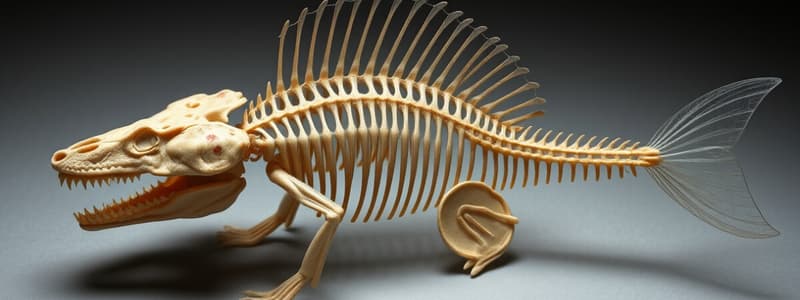Podcast
Questions and Answers
Which of the following is not a class of infraclass Gnathostomata?
Which of the following is not a class of infraclass Gnathostomata?
- Ankylosauria (correct)
- Chondrichthyes
- Acanthodii
- Sarcopterygii
What is the main characteristic of Phylum Chordata?
What is the main characteristic of Phylum Chordata?
They have a dorsal nerve cord, notochord, and post-anal tail.
The earliest ancestors of Chordates were considered to be ______.
The earliest ancestors of Chordates were considered to be ______.
Pikaia
What are the general characteristics of Subphylum Vertebrata?
What are the general characteristics of Subphylum Vertebrata?
Chondrichthyes are known as bony fishes.
Chondrichthyes are known as bony fishes.
When did Chondrichthyes arise?
When did Chondrichthyes arise?
Which classes are considered extinct among the gnathostomes?
Which classes are considered extinct among the gnathostomes?
What is the role of cartilage in Chondrichthyes?
What is the role of cartilage in Chondrichthyes?
The first vertebrates were ______.
The first vertebrates were ______.
How are the teeth and scales of Chondrichthyes different from their skeleton?
How are the teeth and scales of Chondrichthyes different from their skeleton?
Cartilage in Chondrichthyes does not fossilize well.
Cartilage in Chondrichthyes does not fossilize well.
Flashcards are hidden until you start studying
Study Notes
Phylum Chordata
- Comprises subphylum Vertebrata, infraclass Gnathostomata (jaw vertebrates), and class Chondrichthyes (cartilaginous fishes).
Classes of Infraclass Gnathostomata
- Includes Sarcopterygii (Teleostomi => Ostrichthyes), Actinopterygii (Teleostomi => Ostrichthyes), Acanthodii (extinct), Chondrichthyes, and Placodermi (extinct).
Main Characteristics of Chordata
- Chordates exhibit bilateral symmetry and possess a dorsal nerve cord (spinal cord) connecting the brain to muscles and organs.
- Features a notochord as a stiff rod for support, myotomes (muscle blocks), pharyngeal gill slits, and a post-anal tail.
- Blood circulates through a main ventral vessel and a dorsal vessel.
Primitive Chordates
- Ancestor considered to be Pikaia, a 5 cm long organism with tentacles, not a vertebrate.
- Haikouichthyes is a recent fossil viewed as a potential early craniate, possessing a defined skull.
General Characteristics of Subphylum Vertebrata
- Encompasses fishes, reptiles, amphibians, birds, and mammals, all with a vertebral column serving as the main skeletal axis.
- General body structure includes a head, trunk, two pairs of appendages, and a post-anal tail, though often highly modified.
- Development of a cranium (brain case) distinguishes Craniata, first vertebrates were fishes.
The Earliest Fishes
- Jawless fishes, such as ostracoderms (filter-feeders), existed around 500 million years ago.
- Evolution of jawed fishes introduced armored placoderms, which are now extinct.
Devonian Period (The Age of Fishes)
- Lasted approximately 400 million years ago, all five major fish lineages co-existed.
- Lineages included Ostracoderms (extinct), Placoderms (extinct), Chondrichthyes, Acanthodii (extinct), and Osteichthyes, some early Osteichthyes had cartilage.
Class Chondrichthyes
- Includes cartilaginous fishes, with around 850 extant species like chimaeras, sharks, and rays.
- Characterized by a cartilaginous endoskeleton, with only teeth and scales being bony.
Cartilage in Chondrichthyes
- Skeletons made of lightweight, flexible cartilage providing structural support for large sizes.
- Cartilage lacks a blood supply and does not fossilize well compared to bone.
- Adaptations allow for buoyancy and maneuverability, aiding in tighter turns than bony fishes.
Being Cartilaginous
- Cartilaginous features reduce weight, facilitating buoyancy.
- Evolutionarily, bone preceded cartilage in fish evolution; Chondrichthyes result from a secondary loss of bone.
Evolution of Chondrichthyes
- Chondrichthyes evolved in parallel with Osteichthyes, arising approximately 380 million years ago during the Devonian Period.
Studying That Suits You
Use AI to generate personalized quizzes and flashcards to suit your learning preferences.




